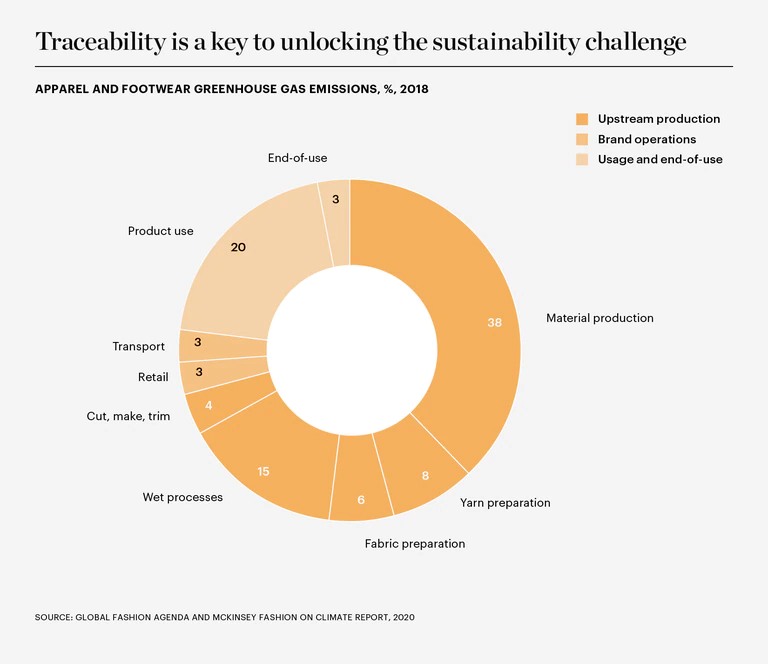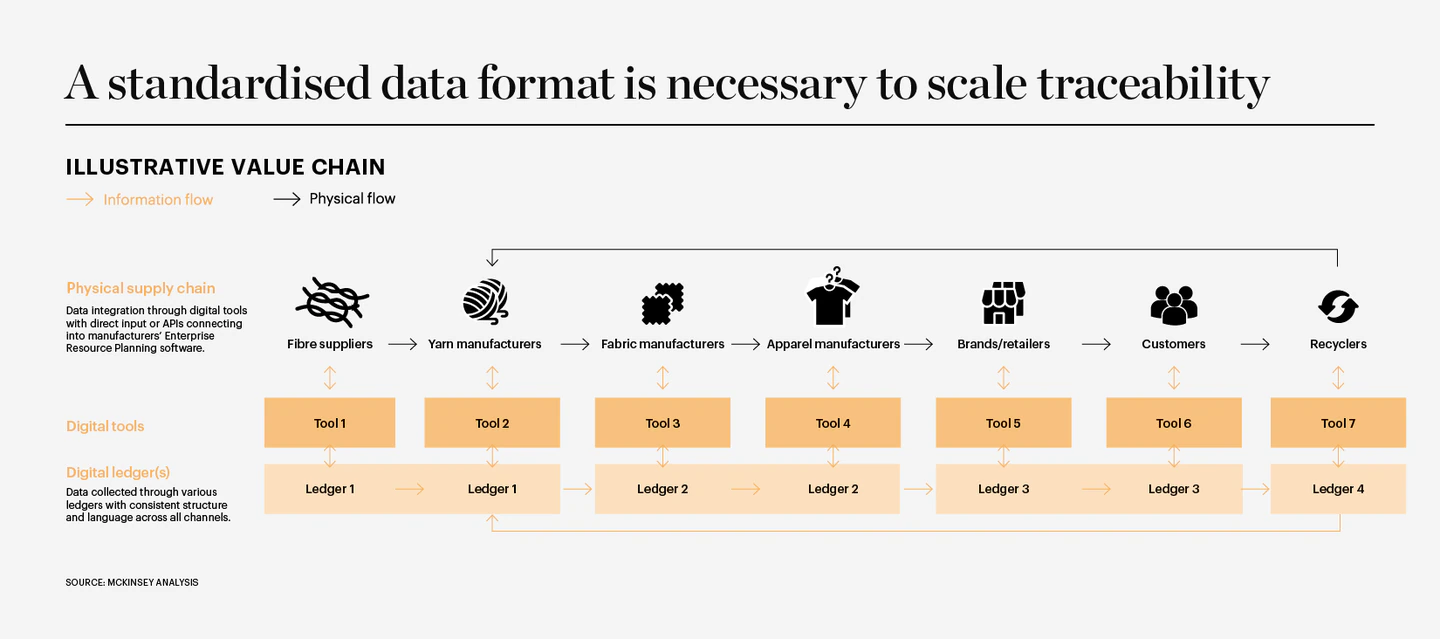
This article first appeared in The State of Fashion: Technology, an in-depth report co-published by BoF and McKinsey & Company.
More than ever, fashion brands are being held accountable for their environmental and social impact. In terms of greenhouse gas emissions alone, it is estimated that the industry is accountable for 2.1 billion tonnes (or 4 percent of the global total), a figure that it set to rise if action is not taken.
Brands are largely ill-equipped to monitor and manage social and environmental practices across their supply chains, including greenhouse gas emissions, of which only 6 percent on average is generated from their direct operations. Fashion players are operating with very limited visibility of their supply chain beyond their tier one suppliers with whom they have direct relationships.
Now, new legislation and the increased frequency of supply chain disruptions, alongside consumer and investor pressure, are forcing corporate action.
If fashion brands are to achieve sustainability objectives, ranging from better materials sourcing to improved regulatory compliance to emissions reduction, they will need to establish full line of sight into how their products are manufactured.
Currently, the industry’s traceability efforts are hampered by manual processes and unreliable data.
Complete traceability entails brands identifying the history, location and distribution of product parts and materials throughout all stages of the supply chain — including contractors and subcontractors. More than 50 percent of fashion decision makers say traceability will be a top-five enabler to reduce emissions in their supply chain before 2025. This visibility provides stakeholders with information that can inform sustainability-related decisions:
- Regulatory compliance: Traceability plays a critical role in helping companies proactively respond to the fast-evolving regulatory landscape, including in the US, where the Securities and Exchange Commission has proposed its Enhancement and Standardization of Climate-Related Disclosures for Investors. This new rule will require US-listed companies to disclose emissions from tiers one, two and three of their supply chains. Also on the horizon is the EU’s proposed legislation as part of its Green Deal that will set mandatory minimum levels for recycled content in products and will require digital twins for products that contain sustainability information to combat misleading marketing, or “greenwashing.”
- Investors and the ESG imperative: Similarly, companies need a greater grip on traceability to demonstrate to the financial community how they are meeting investment criteria relating to environmental, social and governance targets.
- Customer expectations: Finally, customers are increasingly calling on brands to be better equipped to assess and disclose their sustainability claims. In China, 25 percent of customers rank sustainability as one of the top three factors that they considered when purchasing luxury products. In Europe, 60 percent of fashion customers say transparency is important. While just 20 percent currently seek out this information when purchasing, the percentage of customers who are acting on these interests is starting to increase — particularly among younger generations.
Currently, the industry’s traceability efforts are hampered by manual processes and unreliable data. This is exacerbated by the lack of industry-wide standards, leaving both brands and their suppliers to struggle with tracking and aggregating data.
For traceability to operate successfully at scale, a common data language is essential. This will create the level of standardisation required for comparability and allow manufacturers and suppliers to share data more easily with multiple brands, encouraging a higher level of buy-in across the value chain. To achieve a common language, brands will need to collaborate, both in terms of the types of data collected and the way in which key metrics like water usage and emissions are compiled and assigned on a product level.
The industry is showing promising initial signs of moving closer to this objective of great collaboration. Companies such as Kering, LVMH, Fast Retailing and Inditex have adopted the Taskforce on Climate-Related Financial Disclosures to align on how they assess and disclose climate risks and opportunities. Some initiatives offer certification labels (such as Cradle to Cradle) or self-assessment tools (like the Higg Index, developed by the Sustainable Apparel Coalition, an industry-wide non-profit).

There are concerns, voiced by players such as the Changing Markets Foundation, that the fragmented nature of these schemes makes comparability and a holistic and granular view of impact difficult. As industry-wide labelling standards emerge (along with mechanisms to validate the data), consolidation of traceability and impact tracking standards will likely occur and will be an important enabler for the acceleration of traceability efforts given the network effects of such solutions.
The Power of Data
Technology will be critical for the development and adoption of a common data language. Given the complexity and fragmentation of value chains, brands — particularly large ones — will require tracking software for data gathering and marshalling. Brands can look to establish a decentralised ledger (a peer-to-peer shared database with no central administrator) to efficiently collect and distribute data and ensure its reliability — the data within digital ledgers is immutable. These ledgers may be open source or owned by individual brands, or third-parties and start-ups could create data interfaces for specific segments of the value chain.
Such traceability systems — whereby each entity along the value chain inputs data — are far from a reality today. However, pilots are running to test platforms that enable brands to track garments through the supply chain, alongside implementations of off-the-shelf solutions connecting suppliers and brands’ data systems. For example, TextileGenesis, which uses blockchain-based technology to assign a trackable digital token to recycled and organic fibres, has partnered with Fashion for Good, Lenzing and other organisations as well as retailers such as Bestseller, Kering, Zalando and H&M Group to use the technology to validate whether fibres originate from sustainable sources.

Meanwhile, TrusTrace offers a centralised database of certifications and other evidence to document the sustainability claims from retailers, manufacturers and suppliers, as well as third parties such as certification agencies. Adidas, which has targets to use only recycled polyester by 2024 and to make 90 percent of its products in a way that is more sustainable by 2025, will use TrusTrace’s software to track all certified materials used in its products in the next two years.
Owing to the complex and fragmented nature of the value chain, technology is the key enabler to achieving traceability.
In addition, companies such as Applied DNA Sciences are experimenting with physical (for example, RFID) and molecular trackers that can be applied to products at various stages of manufacturing and can store product information. Thread manufacturer American & Efird has adopted molecular trackers to authenticate some lines of recycled thread. However, just 10 percent of senior fashion executives have invested in such physical “track and trace” solutions when seeking to address supply chain visibility and traceability.
Knowledge Sharing
For traceability initiatives to have a meaningful impact, brands will need to be more open about proprietary knowledge about their supply chains. Collaboration is required to achieve a common good. This is happening in some parts of the industry. The Aura Blockchain Consortium has united LVMH, Prada and Richemont-owned Cartier on a shared platform to solve traceability challenges by developing blockchain-based “product passports” for luxury goods. This would provide verified information relating to a product’s entire lifecycle. In addition, H&M Group has launched an open-source B2B service called Treadler to grant industry peers access to its suppliers list. H&M vets suppliers using Higg data and shares information as a paid-for service to allow other brands to engage with H&M-vetted suppliers without having to conduct their own assessment.
The onus will be on big brands with the capital to invest — and, ultimately, the biggest footprints — to lead the charge. It is likely that over time a handful of data platforms will emerge as principal solutions, so there is a potential return on investment for brands who can help develop them.
Traceability will put the industry on track towards a more transparent, accountable future, ensuring that investors, consumers and regulators can interact with brands based on sustainability information they can trust. What’s more, traceability will be critical in establishing a competitive business model. Owing to the complex and fragmented nature of the value chain, technology is the key enabler to achieving traceability. With this, brands need to embrace a new, collaborative mindset to enable information sharing, while extending tools and providing training and support to their suppliers so that they are also able to embrace a more traceable industry.




